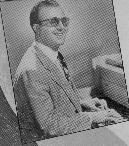


George Shearing enjoys the unique distinction of having had two careers. After reaching the pinnacle of fame in his native England, he had to start all over in this country, unknown and ignored. And once again he has advanced to the front rank.
It was at a meeting of London's "No. 1 Rhythm Club" in 1937 that the 17-year-old product of a local school for the blind came in and broke up the session; not only at the piano, but also playing swing accordion. During the next decade George waxed regularly with large and small groups, wrote arrangements for the top British bands, and won England's Melody Maker poll six times as the country's No. 1 pianist.
George first came to New York on a brief visit in 1945. When, in December, 1947, he returned as a permanent resident, it looked as though he had been wrong in deciding to come to America. Agents were not interested in handling him, radio stations and night clubs all turned him down. Finally, 52nd Street's Three Deuces hired him, and working there in a trio with Oscar Pettiford and J. C. Heard and with other small groups of similar calibre George made enormous strides musically.
The birth of the Quintet was an accident. George had been working on Broadway with a quartet of piano, clarinet, bass, and drums. Because the clarinetist was contractually unable to record with Shearing, a new group was formed to make records, using guitar and vibraharp to blend with the piano. Chuck Wayne on guitar and Margie Hyams on vibraharp achieved such an immediate rapport that after the first record date George decided to keep his group together permanently.
The contract with M-G-M RECORDS and the waxing of September In The Rain at the initial session assured the success of Shearing and his unit. After working together at Cafe Society and other night clubs the five had such a natural feeling for each other's styles that the working out of a new arrangement became largely a matter of instinct--aided by George's brilliantly original concepts and those of his colleagues.
The Quintet has succeeded because its tone-color is easy on the ear and new to this kind of music; because it lets you hear the melody, and because its five members think together and work together like a single instrument. The group has brought something fresh and mellifluous to bop. And make no mistake--every improvised solo passage in everything the Shearing Quintet plays here is bop. The Shearing unit is the living, rhythmic proof that bop is still very much alive.